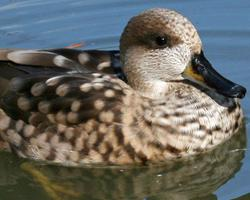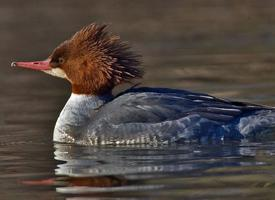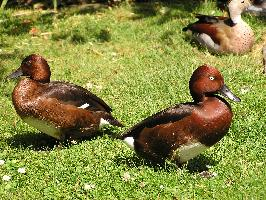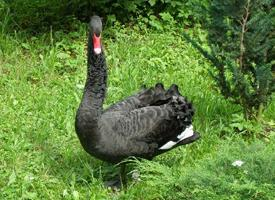
Stav ohrožení
| Neohrožen |
Popis zvířete
The Marbled Duck, scientifically known as Marmaronetta angustirostris, is a distinctive and somewhat enigmatic species of waterfowl belonging to the duck, goose, and swan family Anatidae. This medium-sized duck exhibits a unique combination of features and behaviors that set it apart from its more familiar cousins.Physically, the Marbled Duck is characterized by its muted color palette and the marbled or mottled brown-and-cream pattern that adorns its feathers, lending the species its common name. Adults typically measure between 39 to 42 centimeters in length, with a wingspan that can reach up to 63 centimeters. One of its most notable features is its slender, elongated bill, which is somewhat longer and more tapered than those of other ducks, facilitating its specialized feeding habits.
The plumage of both male and female Marbled Ducks is similar, making them difficult to distinguish based on appearance alone. This lack of sexual dimorphism is somewhat unusual among ducks. Their eyes are surrounded by a noticeable ring of pale feathers, which contrasts with their darker head and provides a striking visual feature. The body is predominantly warm brown, with intricate marbling and speckling that provides excellent camouflage among reeds and marsh vegetation.
Marbled Ducks are found in a variety of wetland habitats, including marshes, lakes, and lagoons, with a preference for shallow, fresh or brackish waters rich in vegetation. Their distribution is somewhat patchy but primarily centers around the Mediterranean basin, extending through parts of North Africa, the Middle East, and into western and central Asia. The species is migratory, with some populations moving southwards to sub-Saharan Africa during the winter months.
Dietarily, the Marbled Duck is omnivorous but shows a preference for aquatic invertebrates, small fish, and plant matter, which it typically forages for by dabbling or up-ending rather than diving. Its elongated bill is adept at sifting through mud and shallow water, allowing it to extract prey with precision.
Breeding behavior in Marbled Ducks is less well-documented than in many other waterfowl species, partly due to their elusive nature and preference for dense, inaccessible habitats. They are known to nest on the ground, often in concealed locations among dense vegetation, where the female lays and incubates a clutch of eggs. The specifics of their mating systems and parental care patterns remain areas of ongoing research.
Conservation status of the Marbled Duck is a growing concern. Classified as Vulnerable by the International Union for Conservation of Nature (IUCN), the species faces threats from habitat destruction, water pollution, and disturbance, leading to declining numbers across much of its range. Conservation efforts are focused on habitat protection and restoration, as well as monitoring population trends to better understand and mitigate the impacts of human activity.
In summary, the Marbled Duck is a fascinating and unique member of the waterfowl community, distinguished by its striking appearance, specialized feeding habits, and the challenges it faces in a changing world. Conservation efforts are crucial to ensure the survival of this distinctive species, whose presence enriches the biodiversity of wetland ecosystems.
Podobná zvířata
Nové fotografie zvířat
Top 10 zvířat
- Chinese water dragon (Physignathus cocincinus)
- Galápagos tortoise (Geochelone nigra complex)
- Dolphin gull (Leucophaeus scoresbii)
- Japanese macaque (Macaca fuscata)
- Colombian red howler (Alouatta seniculus)
- Sea urchins (Echinoidea)
- Moustached guenon (Cercopithecus cephus)
- Diana monkey (Cercopithecus diana)
- Common reed warbler (Acrocephalus scirpaceus)
- Common house mosquito (Culex pipiens)


